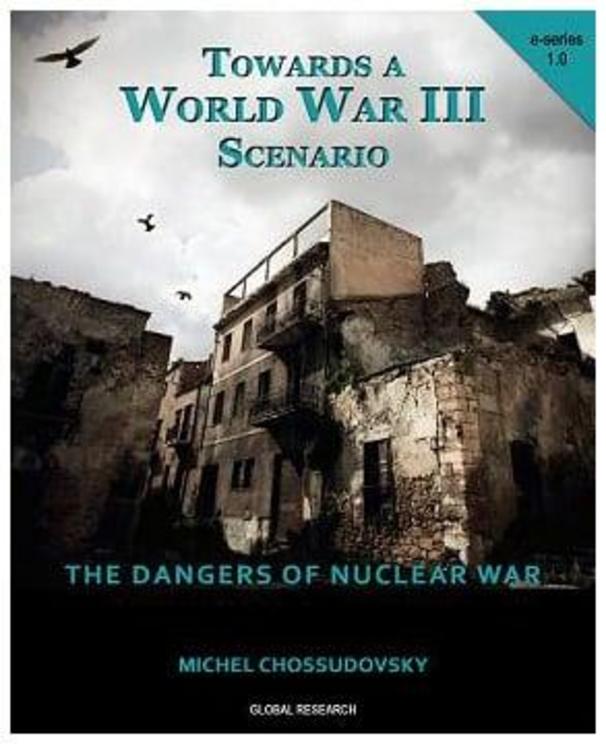Secret meeting on the privatization of Nuclear War held on Hiroshima Day 2003
Behind closed doors at Strategic Command Headquarters
All Global Research articles can be read in 51 languages by activating the “Translate Website” drop down menu on the top banner of our home page (Desktop version).
Visit and follow us on Instagram at @crg_globalresearch.
This article was first published on August 7, 2011.
**
August 6, 1945. Hiroshima Day.
This week we commemorate the 76th anniversary of the bombings of Hiroshima. The Biden Administration is firmly committed to the use of nuclear weapons as an instrument of peace.
The cost of America’s “peace-making” nuclear weapons program is of the order of 1.3 trillion dollars.
...
The focus of US military doctrine since the Bush administration has been on the development of so-called “more usable nuclear weapons”.
George W. Bush’s 2001 Nuclear Posture Review, which was adopted by the US Senate in late 2002. envisaged the development of “a generation of more useable nuclear weapons.” namely tactical nuclear weapons (B61-11 mini-nukes) with an explosive capacity between one third and 6 times times a Hiroshima bomb.
The term “more usable” emanates from the debate surrounding the 2001 NPR, which justified the use of tactical nuclear weapons in the conventional war theater on the grounds that tactical nuclear weapons, namely bunker buster bombs with a nuclear warhead are, according to scientific opinion on contract to the Pentagon “harmless to the surrounding population because the explosion is underground.”
Michel Chossudovsky, August 6, 2019, August 3, 2021
***
The text below is an excerpt from Michel Chossudovsky’s Towards a World War Three Scenario, The Dangers of Nuclear War. first published in 2011.
***
At no point since the first atomic bomb was dropped on Hiroshima on August 6th, 1945, has humanity been closer to the unthinkable – a nuclear holocaust which could potentially spread in terms of radioactive fallout over a large part of the Middle East.
All the safeguards of the Cold War era, which categorized the nuclear bomb as “a weapon of last resort”, have been scrapped. “Offensive” military actions using nuclear warheads are now described as acts of “self-defense”.
The casualties from the direct effects of blast, radioactivity, and fires resulting from the massive use of nuclear weapons by the superpowers [of the Cold War era] would be so catastrophic that we avoided such a tragedy for the first four decades after the invention of nuclear weapons.1
During the Cold War, the doctrine of Mutually Assured Destruction (MAD) prevailed, namely that the use of nuclear weapons against the Soviet Union would result in “the destruction of both the attacker and the defender”. In the post Cold war era, US nuclear doctrine was redefined.
The dangers of nuclear weapons have been obfuscated. Tactical weapons have been upheld as distinct, in terms of their impact, from the strategic thermonuclear bombs of the Cold War era. Tactical nuclear weapons are identical to the strategic nuclear bombs. The only things that differentiates these two categories of nuclear bombs are:
1) their delivery system;
2) their explosive yield (measured in mass of trinitrotoluene (TNT), in kilotons or megatons.
The tactical nuclear weapon or low yield mini-nuke is described as a small nuclear bomb, delivered in the same way as the earth penetrating bunker buster bombs. Tactical nuclear weapons, in terms of in-theater delivery systems are comparable to the bombs dropped on Hiroshima and Nagasaki in August 1945.
The Pentagon’s 2001 Nuclear Posture Review envisaged so-called “contingency plans” for an offensive “first strike use” of nuclear weapons, not only against “axis of evil” countries (including Iran and North Korea) but also against Russia and China.2
Remember Hiroshima: No Danger of Nuclear War? The Pentagon’s Plan to Blow up the Planet
The adoption of the NPR by the US Congress in late 2002 provided a green light for carrying out the Pentagon’s pre-emptive nuclear war doctrine, both in terms of military planning as well as defense procurement and production. Congress not only rolled back its prohibition on low yield nuclear weapons, it also provided funding “to pursue work on so-called mini-nukes”. The financing was allocated to bunker buster (earth penetrator) tactical nuclear weapons as well as to the development of new nuclear weapons.3
Hiroshima Day 2003: Secret Meeting at Strategic Command Headquarters
On August 6, 2003, on Hiroshima Day, commemorating when the first atomic bomb was dropped on Hiroshima (August 6 1945), a secret meeting was held behind closed doors at Strategic Command Headquarters at the Offutt Air Force Base in Nebraska.
Senior executives from the nuclear industry and the military industrial complex were in attendance. This mingling of defense contractors, scientists and policy-makers was not intended to commemorate Hiroshima. The meeting was intended to set the stage for the development of a new generation of “smaller”, “safer” and “more usable” nuclear weapons, to be used in the “in-theater nuclear wars” of the 21st Century.
In a cruel irony, the participants to this secret meeting, which excluded members of Congress, arrived on the anniversary of the Hiroshima bombing and departed on the anniversary of the attack on Nagasaki. More than 150 military contractors, scientists from the weapons labs, and other government officials gathered at the headquarters of the US Strategic Command in Omaha, Nebraska to plot and plan for the possibility of “full-scale nuclear war”, calling for the production of a new generation of nuclear weapons – more “usable” so-called “mini-nukes” and earth penetrating “bunker busters” armed with atomic warheads.4
According to a leaked draft of the agenda, the secret meeting included discussions on “mini-nukes” and “bunker-buster” bombs with nuclear war heads “for possible use against rogue states”:
We need to change our nuclear strategy from the Cold War to one that can deal with emerging threats… The meeting will give some thought to how we guarantee the efficacy of the (nuclear) stockpile.5
The Privatization of Nuclear War: US Military Contractors Set the Stage
The post 9/11 nuclear weapons doctrine was in the making, with America’s major defense contractors directly involved in the decision-making process.
The Hiroshima Day 2003 meetings had set the stage for the “privatization of nuclear war”. Corporations not only reap multibillion-dollar profits from the production of nuclear bombs, they also have a direct voice in setting the agenda regarding the use and deployment of nuclear weapons.
The nuclear weapons industry, which includes the production of nuclear devices as well as the missile delivery systems, etc., is controlled by a handful of defense contractors with Lockheed Martin, General Dynamics, Northrop Grunman, Raytheon and Boeing in the lead. It is worth noting that barely a week prior to the historic August 6, 2003 meeting, the National Nuclear Security Administration (NNSA) disbanded its advisory committee which provided an “independent oversight” on the US nuclear arsenal, including the testing and/or use of new nuclear devices.6
The above text is an excerpt from Michel Chossudovsky’s
Towards a World War Three Scenario, The Dangers of Nuclear War.
E-Book Series No. 1.0
Global Research Publishers
Montreal, 2011,
ISBN 978-0-9737147-3-9
76 pages (8.5×11)
Tables, color photographs, maps, text boxes.
Active hyperlinks to major references in the text, hyperlinked footnotes.

For further details click here
Order your copy of this important new book from Global Research here
DETAILED TABLE OF CONTENTS
PREFACE
A New War Theater in North Africa
Operation Odyssey Dawn
Nuclear Weapons against Libya? How Real is the Threat?
America’s Long War: The Global Military Agenda
How to Reverse the Tide of War
World War III Scenario
Acknowledgments
CHAPTER I: INTRODUCTION
The Cult of Killing and Destruction
America’s Mini-nukes
War and the Economic Crisis
Real versus Fake Crises
CHAPTER II: THE DANGERS OF NUCLEAR WAR
Hiroshima Day 2003: Secret Meeting at Strategic Command Headquarters
The Privatization of Nuclear War: US Military Contractors Set the Stage
9/11 Military Doctrine: Nuclear Weapons and the “Global War on Terrorism”
Al Qaeda: “Upcoming Nuclear Power”
Obama’s Nuclear Doctrine: The 2010 Nuclear Posture Review
Post 9/11 Nuclear Doctrine
“Defensive” and “Offensive” Actions
“Integration” of Nuclear and Conventional Weapons Plans
Theater Nuclear Operations (TNO)
Planned Aerial Attacks on Iran
Global Warfare: The Role of US Strategic Command (USSTRATCOM)
Nuclear Weapons Deployment Authorization
Israel’s Stockpiling of Conventional and Nuclear Weapons
The Role of Western Europe
Germany: De Facto Nuclear Power
Pre-emptive Nuclear War: NATO’s 2010 Strategic Concept
The World is at a Critical Crossroads
CHAPTER III: AMERICA’S HOLY CRUSADE AND THE BATTLE FOR OIL
America’s Crusade in Central Asia and the Middle East
“Homegrown Terrorists”
The American Inquisition
Washington’s Extrajudicial Assassination Program
The Battle for Oil
The Oil Lies in Muslim Lands
Globalization and the Conquest of the World’s Energy Resources
CHAPTER IV: PREPARING FOR WORLD WAR THREE
Media Disinformation
A “Pre-emptive” Aerial Attack Directed Against Iran would Lead to Escalation
Global Warfare
US “Military Aid”
The Timetable of Military Stockpiling and Deployment
World War III Scenario
The United Nations Security Council
The American Inquisition: Building a Political Consensus for War
CHAPTER V: TARGETING IRAN WITH NUCLEAR WEAPONS
Building a Pretext for a Pre-emptive Nuclear Attack
“Theater Iran Near Term”
The Military Road Map: “First Iraq, then Iran”
Simulated Scenarios of a Global War: The Vigilant Shield 07 War Games
The Role of Israel
Cheney: “Israel Might Do it Without Being Asked”
US Israel Military Coordination
Tactical Nuclear Weapons directed against Iran
Radioactive Fallout
“The Mother of All Bombs” (MOAB) Slated to be Used Against Iran
Extensive Destruction of Iran’s Infrastructure
State of the Art Weaponry: “War Made Possible Through New Technologies”
Electromagnetic Weapons
Iran’s Military Capabilities: Medium and Long Range Missiles
Iran’s Ground Forces
US Military and Allied Facilities Surrounding Iran
CHAPTER VI: REVERSING THE TIDE OF WAR
Revealing the Lie
The Existing Anti-War Movement
Manufacturing Dissent
Jus ad Bellum: 9/11 and the Invasions of Yugoslavia and Afghanistan
Fake Antiwar Activism: Heralding Iran as a Nuclear Threat
The Road Ahead
The Antiwar Movement within the State Structure and the Military
Abandon the Battlefield: Refuse to Fight
The Broader Peace Process
What has to be Achieved
Order your copy of this important book from Global Research here
Related Articles
15 April 2017
24 April 2021
Obama and the "Legal Crimes of War": Hiroshima was Destroyed. "It was an Act of God"
7 June 2016
The original source of this article is Global Research
Copyright © Prof Michel Chossudovsky, Global Research, 2021

